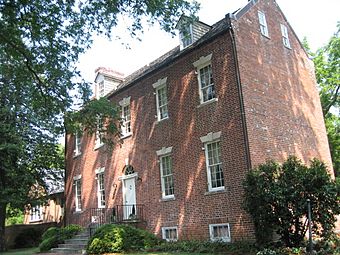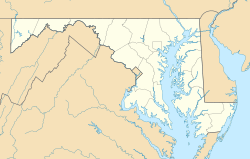Marietta (Glenn Dale, Maryland) facts for kids
Quick facts for kids |
|
|
Marietta
|
|
 |
|
| Nearest city | 5626 Bell Station Rd., Glenn Dale, Maryland |
|---|---|
| Area | 24 acres (9.7 ha) |
| Built | 1812 |
| Architectural style | Federal |
| NRHP reference No. | 94000729 |
| Added to NRHP | July 25, 1994 |
Marietta is a special old house and former farm in Glenn Dale, Maryland. It's located in Prince George's County, Maryland, USA. This historic place is recognized on the National Register of Historic Places. It is also part of the National Underground Railroad Network to Freedom.
The Marietta House Museum has a house from the Federal era. It also includes a cemetery, a root cellar, and a harness room. You can also see Gabriel Duvall's original law office building. The site covers 25 acres today. Visitors can explore the grounds and tour the buildings. They can learn about the people who lived and worked there.
The Story of Marietta House
Marietta is a large brick house built between 1812 and 1813. It has 2.5 stories and was designed in the Federal style. This style was popular in the United States during the early 1800s. The house has a classic "I-house" shape, which means it is long and narrow.
The main part of the house has five windows across the front. The front door is in the middle. A two-story wing was added to the back around 1832. Another L-shaped wing was built in 1968. Marietta stands on pretty, landscaped grounds. There are also two other old buildings nearby. These include a brick law office and a stone and brick root cellar. The root cellar was used to store food and harnesses.
Who Built Marietta?
Enslaved people built Marietta under the direction of Gabriel Duvall. He was born in 1752 and passed away in 1844. Mr. Duvall was a very important person in Maryland and the United States. He worked as a lawyer and served in the Maryland government. He was also a U.S. Congressman. Later, he became a U.S. Comptroller. From 1811 to 1835, he served as a U.S. Supreme Court Justice. This meant he was one of the highest judges in the country.
Life at Marietta
The Duvall family forced many people to work at Marietta. These enslaved people lived and labored on the property. Slavery ended in Maryland in 1864. Between 1812 and 1865, about nine to forty enslaved people lived at Marietta each year.
Some of the families who were enslaved there included the Duckett, Butler, Jackson, and Brown families. Their families lived and worked at Marietta for many generations. After Justice Duvall passed away in 1844, his family continued to live at Marietta. They owned the property until 1902.
Gallery





